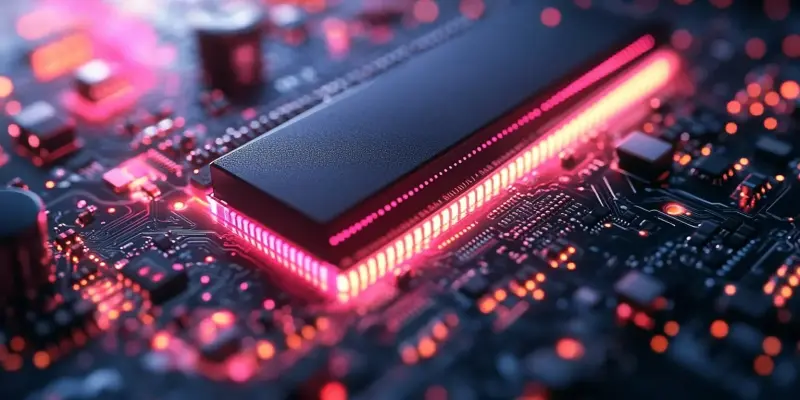Memory technology has been advancing rapidly, and Micron is at the forefront of these transformations with its next-generation High Bandwidth Memory (HBM4) and HBM4E. These advancements promise to revolutionize the market by 2026. The stakes are high as Micron competes with established industry giants like SK Hynix and Samsung. The focus is on integrating memory and logic semiconductors within a single package to enhance performance efficiency by discarding the need for separate packaging. Taiwan Semiconductor Manufacturing Company’s (TSMC) foundry services will play a pivotal role in this initiative, aligning Micron’s efforts with those of SK Hynix.
Integration of Memory and Logic Semiconductors
Achieving Performance Efficiency with Single Package Integration
Micron’s innovative approach involves integrating memory and logic semiconductors into a single cohesive package, thereby eliminating the inefficiencies associated with separate packaging technologies. This integrated design not only streamlines the manufacturing process but also significantly boosts performance and efficiency. The use of TSMC’s foundry services for the logic semiconductors ensures state-of-the-art manufacturing techniques are employed, further enhancing the final product’s capabilities.
One of the main advantages of this integration is the reduction in latency, as data does not need to travel between separate chips. This can be particularly beneficial in high-performance computing environments where speed is crucial. Moreover, the simplified packaging can lead to cost reductions, making this technology more accessible to a broader range of applications and industries. By leveraging TSMC’s expertise, Micron aims to stay competitive in a market where SK Hynix and Samsung have long held dominant positions.
Aligning with SK Hynix’s Strategy
To compete effectively, Micron has aligned its approach with that of SK Hynix by fully integrating memory and logic semiconductors. This strategy not only aims to enhance performance but also seeks market timing alignment to leapfrog SK Hynix and Samsung in the competitive landscape. The collaboration with TSMC means that Micron can utilize advanced logic foundry services, comparable to what SK Hynix employs, thus ensuring parity in technological capabilities.
In doing so, Micron aims to capitalize on emerging trends and demands in the tech industry, particularly from sectors requiring high-speed data processing and efficient energy usage. By focusing on high bandwidth, low latency, and energy-efficient memory solutions, Micron is positioning itself to meet the evolving needs of technologies such as artificial intelligence and machine learning. This strategic move demonstrates Micron’s commitment to innovation and its intention to be a leader in the next wave of technological advancements.
Advancements in HBM4 and HBM4E
Significant Performance Improvements with HBM4
Micron’s HBM4 represents a substantial leap forward in high bandwidth memory technology, promising performance improvements exceeding 50% compared to its predecessor, HBM3E. This breakthrough is made possible by leveraging the latest 1β process technology, which fine-tunes the manufacturing process to deliver higher performance and greater power efficiency. Such advancements are critical as memory demands continue to grow in sectors like artificial intelligence and high-performance computing.
The impact of HBM4 is already being felt, with anticipated adoption in NVIDIA’s Rubin AI architecture and AMD’s Instinct MI400 lineup. This early adoption by industry leaders underscores the value and potential of HBM4 technology in real-world applications. By 2025, production lines for HBM4 are already booked, indicating strong market interest and demand. This preemptive booking of production lines not only highlights the technology’s expected importance but also reflects the competitive edge Micron seeks to gain in the industry.
The Paradigm Shift Introduced by HBM4E
Looking beyond HBM4, Micron is also developing HBM4E, a technology that signifies a major paradigm shift in the memory business. Unlike traditional approaches, HBM4E allows for the customization of the logic base die for specific customers, employing an advanced logic foundry manufacturing process from TSMC. This customization capability is a game-changer, offering more tailored solutions to meet diverse and specific market needs effectively.
By permitting such flexibility, Micron can cater to niche market segments, ensuring that their technology aligns with particular requirements. This not only improves the overall performance of the memory but also potentially enhances Micron’s financial performance by opening up new revenue streams. The introduction of HBM4E places Micron in a strong position to lead the market, offering unique solutions that address emerging demands in computing realms requiring high efficiency and speed.
Strategic Positioning and Market Impact
Partnership with TSMC and Market Timing
The strategic partnership between Micron and TSMC is pivotal in ensuring the timely delivery and advanced manufacturing of HBM4 and HBM4E technologies. This alliance aligns Micron with some of the best foundry services available, ensuring high-quality production and competitive technological capabilities. By doing so, Micron is setting itself up for success in hitting its target market timing, which is crucial in staying ahead in the competitive landscape.
Aligning with TSMC also allows Micron to focus resources on innovation and development, knowing that the manufacturing aspects are in capable hands. This ensures that Micron not only meets current market demands but is also prepared for future technological shifts. The anticipated adoption of HBM4 in significant AI architectures further cements Micron’s leadership position and potential future impact, signaling that the company is well-positioned to define the next generation of high-performance computing memory solutions.
Expected Evolution and Industry Dominance
Memory technology is evolving at a rapid pace, and Micron is leading these advancements with its cutting-edge High Bandwidth Memory (HBM4) and HBM4E. These innovations are expected to bring significant changes to the market by 2026. Micron faces stiff competition from well-established players like SK Hynix and Samsung. The company’s strategy involves integrating memory and logic semiconductors within a single package to boost performance efficiency by eliminating the need for separate packaging. Taiwan Semiconductor Manufacturing Company’s (TSMC) foundry services will be crucial to this effort, helping align Micron’s initiatives with those of SK Hynix. The collaboration with TSMC is expected to enhance the production capabilities and technological prowess required to stay competitive. As the memory technology industry continues to evolve, Micron’s advancements in HBM4 and HBM4E and its strategic partnerships will play a vital role in setting new standards and driving the industry’s future growth.

